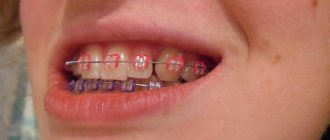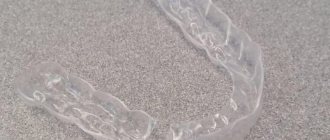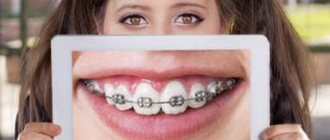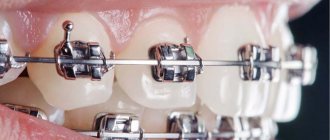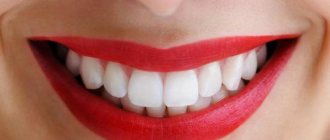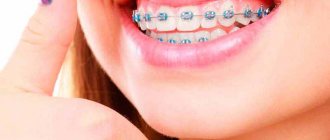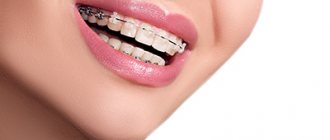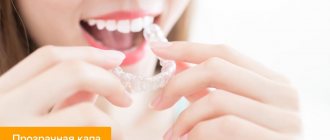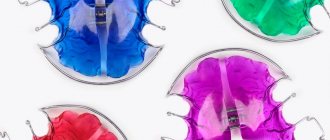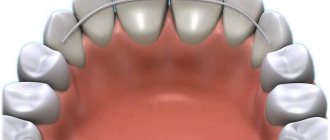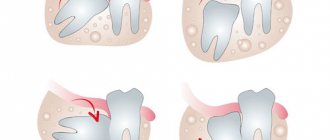It is a pity that not everyone in our world is naturally blessed with beautiful and straight teeth. Many people resort to considerable effort and great expense in order to have a more or less aesthetic smile. After all, uneven teeth are not only unsightly in appearance, but also cause serious changes in the bite, which in turn leads to various diseases. Of course, only an orthodontist can perfectly straighten the teeth, for example, by installing a braces system. People often ask whether it is possible and, if so, how to make braces at home?
More recently, people were embarrassed to wear braces. They considered this system ugly and unaesthetic. Therefore, even when talking, they tried to cover their mouth with their hand. Today you can notice completely different behavior. Braces are considered not only a necessary device for straightening teeth, but are also trendy devices that add a certain zest to a person. Now people are proud of the braces on their teeth and show them off to everyone.
Today you can often find a variety of information about home teeth straightening. Let's try to figure out how this is done.
To be objective, let’s say right away that it is possible to create braces at home, but you won’t be able to correct your teeth with home braces, but you can add some shock value to your image. Homemade braces are good to wear to a disco or to a photo shoot.
Causes of crooked teeth
There are several factors that can cause crooked teeth. These include:
- Genetic predisposition.
- Bad habits in childhood. These include thumb sucking, nail biting, prolonged pacifier sucking, and others.
- Lack of proper attention to the problem is untimely removal of baby teeth, as a result of which the permanent tooth grows with deviation forward or backward.
- Excessive grinding of food. The child's chewing apparatus must bear the load. If they are missing, the muscles do not develop correctly and the teeth may grow unevenly.
How to care for braces
Caring for the outside of braces is not as easy as it seems. In order to clean this part, you need a special brush for braces. It should have a depression in the center of the bristles. This brush will help you thoroughly clean the outside of your braces. It must be remembered that you can additionally use a mono-beam brush for braces.
We suggest you read: Wisdom tooth is loose, what to do
To clean the surface of the teeth in the gum area, you need to use a toothbrush with soft bristles. You should brush your teeth from the outside and inside, paying special attention to the gum line. Dental floss and specialized brushes are usually used to clean dental spaces.
One of the most important questions that worries patients is: what kind of paste should be used to clean braces?
To solve such a delicate problem, you need to contact a specialist who will give recommendations on choosing a paste. If you don’t have the time or opportunity to see a doctor, then you should adhere to the following criteria:
- Toothpaste should be such that it does not damage tooth enamel.
- You should not use a paste that has a strong taste.
- Toothpaste contains fluoride.
In practice, there are very often cases when it is not possible to clean the braces, for example, in a cafe or restaurant; in this case, you can treat the oral cavity with a specially designed rinse or warm water. This kind of procedure will greatly ease the problem of caring for the brace system in unforeseen circumstances. For those who wear braces, the recommended brushing time is 3 to 5 minutes per day during each procedure.
Mistakes that make it difficult to straighten teeth
There are several mistakes and misconceptions, following which can significantly harm and slow down the process of straightening your teeth in the future. Among them:
- Neglecting the problem, acting independently without consulting a doctor. Changes in normal occlusion have their own nature, which should be understood before actions to correct it begin.
- Waste of time. Often parents see a problem, but put off taking action to eliminate it. As a result, this can result in a more complicated situation and much more time spent on treatment. The sooner action is taken to correct the defect, the simpler, faster and cheaper the process will be.
- Tooth extraction without prior consultation. There is an opinion that it is easier to remove an uneven tooth and replace it with a denture. To date, there are no prostheses that completely correspond to natural teeth. A good specialist will not recommend this unless absolutely necessary. Therefore, it is better to consult several doctors to determine the correct treatment tactics.
- Refusal to remove baby teeth. If this helps eliminate the defect, it is possible and necessary to remove baby teeth. Delaying will not solve the problem, but will only make things worse.
Is it possible not to correct the bite?
There are patients who do not want to correct their bite either with braces or alternative options, believing that “slightly uneven teeth” are normal.
Dentists say the opposite. A bad bite is not only a matter of aesthetics, but primarily of health. Here are just some of the problems that can result from improperly aligned teeth:
- rapid abrasion of teeth and exposure of roots due to incorrect chewing load;
- frequent headaches due to dysfunction of the joint connecting the temporal bone and the lower jaw;
- diction disorders;
- difficult hygiene, which leads to the development of caries and other dental diseases;
- pathologies of the digestive tract arising from poor chewing of food;
- disorders in the musculoskeletal, respiratory and other systems of the body.
Thus, the bite is directly related to health, so it is necessary to straighten the teeth, but it is important to choose the correct correction method together with the dentist.
Is it possible to straighten your teeth yourself?
It is important to separate the concepts of self-leveling without the help of doctors and using home methods after consulting a specialist. Methods of the “folk” category are not used by modern medicine. They are also not among the known treatments in the past. Options like loosening, tying threads, etc. are nothing more than a way to cause harm.
Instead, there are more and more ways to “do it yourself” to straighten your teeth. They involve eliminating braces, using much simpler systems and minimizing visits to the dentist's office. These methods can be conditionally classified as home methods, since they involve wearing orthodontic systems at home.
History of origin
For the first time, fake braces began to be worn in Southeast Asia. The fashion for them was introduced by such stars as Andiga Kangen, Earn The Star, Gwen Stefani. They are also associated with the aggressive “dek wehn when” motorbike subculture.
Counterfeit products are designed to create the image of a rich person. For example, the cost of real structures in Bangkok is more than $1,000. This amount is equal to half the annual income for most residents of the country.
A huge demand for products has created a black market. On it, fake systems cost about $100.
The fakes turned out to be life-threatening. After the death of teenagers in Thailand, their sale is prohibited by law.
Violation is punishable by 6 months in prison and a $1,600 fine.
But some enterprising young people are not afraid of statistics, and they resort to creating beautiful dental jewelry on their own.
Review of Avalon polyurethane braces, pros and cons of the system.
Read here what braces Cassis offers.
At this address https://www.vash-dentist.ru/ortodontiya/breketyi/vestibulyarnyie/vse-chto-nuzhno-znat-o-kompozitnyih.html we offer to evaluate the aesthetics of composite braces using photographs of patients.
Mouth guards for teeth alignment
Alignment using aligners is a modern, effective method that allows you to do without braces. For this purpose, transparent systems resembling cases are used. They can be removed while eating and are easy to clean. As a rule, the aligners are replaced with new ones every two weeks. Among the advantages of the method:
- Aesthetic appearance – the systems are transparent and almost invisible when worn.
- There is no negative effect on the gums.
- Easy to clean and can be removed while eating.
- Individual production taking into account all the characteristics of the patient.
- The patient receives the entire set at once; there is no need to visit the orthodontist frequently.
Mouthguards are used at any age, but most often for adults. Disadvantages include high cost and inability to treat severe malocclusions.
Instructions for making braces
How to make braces? Not very difficult. You can make devices from available items.
Here is a list of materials that will be needed during the process:
- Large size paper clips.
- Wire.
- Paper plate or other convenient surface.
- Sandpaper.
- Super glue.
- Pliers.
- Orthodontic wax.
- Beads (preferably different colors).
- Earrings in the shape of a butterfly.
So, let's describe the technology of how to make braces at home.
Braces at home from a paper clip
- Bend the object into a straight line.
- Make the paperclip into the shape of a tooth row, that is, bend it in a U-shape.
- Go to the mirror and stretch your mouth into a smile. Assess how many teeth are visually visible. By counting them, you will find out how many beads you will need in the future.
- Take the beads and attach them to the paperclip. Remember to maintain the correct distance between objects, equal to the distance between the teeth. The beads should be located directly in the center of the tooth. Now raise the paperclip to your teeth and smile widely. Evaluate what has been done.
- Place the paper clip on the paper surface and glue the beads to the wire with non-toxic glue. The beads should stick very well to the paper clip. There should be enough glue. During gluing, the beads and paper clip should not stick to the paper surface. If excess glue suddenly forms, it must be carefully removed from the wire. Average holding time of a glued structure: 4 weeks.
- Make the beaded paperclip into an L shape using pliers. Make folds on both sides. At the same time, try to achieve a level base. Be patient and do the folds slowly.
- Take orthodontic wax (you can find it in pharmacies.) Make two balls from it. Thread the ends of your homemade braces through these balls. For fastening, in addition to wax, you can use chewing gum.
- The structure is ready. Secure it to your teeth for a comfortable feeling.
Sequence of making wire braces
- Take silver craft wire. Give it a U shape.
- Make hooks from the ends of the wire for fastening using pliers. In this case, there is no need to bend them until the very end.
- Choose a suitable elastic band. Find a rubber band that is not too thick and is long enough that it stretches across all the front teeth.
- Attach the elastic band to the wire. Perform movements carefully so as not to damage the structure. Hang the elastic on one hook, pull it tight and secure it on the next side. Squeeze the hooks using pliers. The elastic band should hold very tightly.
- Take small earrings that look like a butterfly. Number of earrings needed: 6. Attach this number. In this case, the back of the earrings should be on the wire.
- Make a fitting to align the butterflies. After assessing the result, make the necessary movements so that the earrings are in the center of the teeth.
- Prepare brackets for the bottom row. The execution sequence differs little from creating braces for the top row. The only thing you won't need to do is attach butterfly earrings. The quantity made will be enough for the aesthetic appearance of the structure.
Children's lip bumpers and plates
These systems are good when the malocclusion is not fixed. The principle of the plate is simple: pressure is applied to the teeth, causing them to fall into place. Bumpers work for children under five years of age. These are peculiar arches located along the dentition and prevent malocclusion.
Devices for self-correction of crooked teeth are selected individually by a specialist after consultation and examination of the patient. Only in this case can you get an excellent result as quickly and simply as possible.
Aligners for bite correction
Aligners, or aligners, are used as an alternative to traditional braces. They have been widely used abroad for bite correction for several decades; in our country they began to be used relatively recently, but are quickly gaining popularity.
Aligners are transparent covers that apply constant pressure to the teeth and thereby move them in the right direction. In the production of aligners, three-dimensional technologies are used, due to which it is possible to achieve a tight fit to the tooth, correct load distribution and a predictable result.
Aligners are made from a material that combines a thin structure (no thicker than a millimeter) and high strength. Due to their softness and flexibility, they are gentle on the teeth and do not damage the enamel during the bite correction process. Other advantages of aligners are simple installation, ease of care and an aesthetically pleasing smile. In addition, the aligner can be removed before eating and brushing your teeth, allowing you to indulge in different foods and maintain a good level of oral hygiene.
Despite the benefits, aligners are not recommended for every patient. The possibility of orthodontic correction using this method should be discussed individually with the dentist.
If the doctor has approved the aligners for a particular patient, the process of installing them will take place in several stages:
- The dentist makes a three-dimensional model of the patient's jaw, which is sent to production for the manufacture of aligners.
- At the next appointment, the patient receives several pairs of aligners and recommendations for wearing and caring for the aligners. As a rule, they should be worn up to 22 hours a day, changing different pairs as recommended by the doctor.
- The duration of treatment is individual, but at the first stage you will need to visit the dentist once every 1-1.5 months.
Although many dentists believe that the best alternative to braces is aligners, they are not the only alternative method for straightening teeth.
Trainers
Used for minor curvatures. These are silicone structures with a spring arch and individual pockets for each tooth. They are mainly used for children under 12 years of age, and are less commonly used for adult patients. Adult trainers are more rigid and are made of polypropylene. Trainers not only move teeth to the right places, but also help train the muscles and the entire dentofacial apparatus to the correct position.
Advantages of trainers:
- Invisible when worn.
- They do not cause discomfort.
- Easy to remove and clean.
- Minimum doctor visits.
- Wearing mainly at night, during the day one hour is enough.
Reviews
There are both enthusiastic and negative reviews on the Internet.
Some people used the devices to create a Halloween costume, while others damaged the mucous membranes of their mouth due to improper use.
In the comments to the article, you can share your reviews about fake braces.
If you find an error, please select a piece of text and press Ctrl+Enter.
Tags: braces vestibular braces
Did you like the article? stay tuned
Previous article
Features of restoring damaged teeth with half-crowns
Next article
Unique Sia braces – the orthodontic art of Italy
Questions and answers
In 2010, she went to a Swiss clinic in St. Petersburg.
From there they sent me to Vegria where they placed implants on both jaws, but the bite was set incorrectly, so the implants did not take root; they tried to correct it, but it didn’t work. Can you help me? In 2010, she went to a Swiss clinic in St. Petersburg. From there they sent me to Vegria where they placed implants on both jaws, but the bite was set incorrectly, so the implants did not take root; they tried to correct it, but it didn’t work. Can you help me?
Hello! We will definitely try to help you. Our doctors have extensive practical and theoretical experience in basal implantation. First, it will be necessary to conduct a diagnosis to understand the causes of problems with implants and the consequences of a broken bite. This can be done at an initial consultation at our clinic. If you have an electronic orthopantomogram or computed tomography, you can send the pictures to us by email to receive a preliminary doctor’s opinion. You can find out more detailed information and sign up for a free consultation by phone (free for regions). Sincerely, Patient Support Center SIMPLADENT+ 7 (495) 789-42-02+8 800 333-53-41
Other questions
Other jobs
